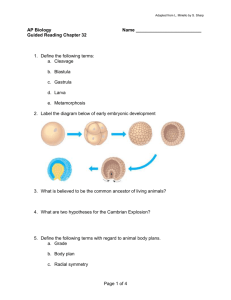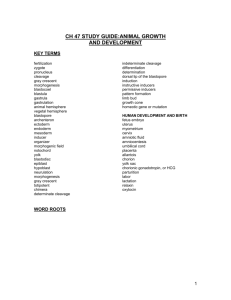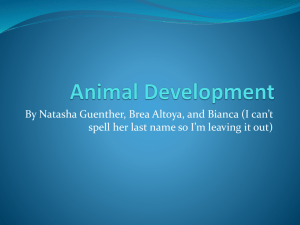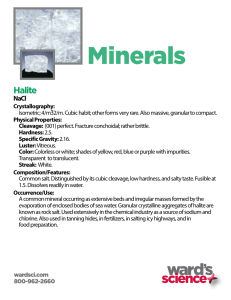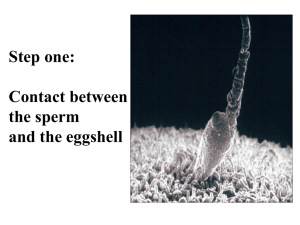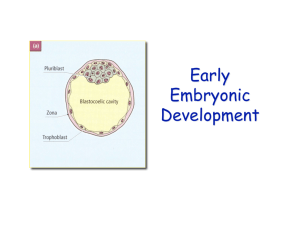Thomas Auditorium Test
advertisement
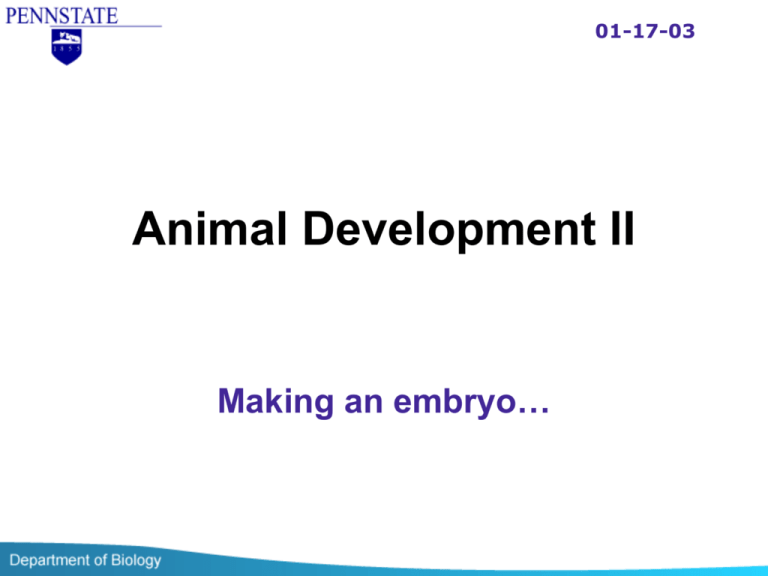
01-17-03 Animal Development II Making an embryo… Where were we Remember gametogenesis Spermatogenesis Oogenesis Back to fertilization What are model organisms? What are the models for studying fertilization? The rules of engagement…(fig 60.3) What does the sperm encounter first? How can it get through the jelly coat? More about fertilization What is penetration (aka. the acrosome reaction)? (fig 60.3) Remember the acrosome? Remember the jelly coat/zona pellucida? What happens when the acrosome encounters jelly coat? What are the signals? What are hydrolytic enzymes? What do they do? More about fertilization More How does the sperm penetrate jelly coat? What is the acrosomal process What happens at the vitelline membrane? acrosomal reaction… Why are receptors important? What happens next? Sperm and egg membranes fuse HOORAY!!! Fig 60.3 More about fertilization What is the situation? How many eggs are available? How many sperm are available? Only ONE winner! What is polyspermy? How is polyspermy prevented? Fast block to polyspermy Slow block to polyspermy The fast block to polyspermy What is membrane potential? What happens to the membrane potential upon sperm fusion? How does depolarization prevent polyspermy? How long does the fast block to poplyspermy last? The slow block to polyspermy How does the slow block work? What is signal transduction? What are second messengers? Why do we need them? More about the slow block Where are intracellular Calcium stores? How is calcium release triggered? How does it radiate over surface of egg? Doing the Calcium wave… http://sdb.bio.purdue.edu/dbcinema/ Campbell fig 47.3 More about the slow block What does calcium release do? Cortical granules fuse with PM Release contents into perivitelline space What are cortical granules? Where are they located? What do they contain? enzymes mucopolysacchariddes More about the slow block What do mucopolysaccharides do in perivitelline space? Remember osmosis? How do mucopolysaccharides affect osmolarity? What does this do to perivitelline space? More about the slow block What do the enzymes from cortical granules do? What happens when polysaccharides become crosslinked? How would this affect sperm penetration? How long does all of this take? Let’s talk about cleavage! What is cleavage? How often does it occur? Does the zygote increase in size? What are blastomeres? More about cleavage What effect does yolk have on cleavage? Isolecithal Mesolecithal Telolecithal isolecithal mesolecithal telolecithal More about cleavage What types of cleavage are there? What is holoblastic cleavage? What is meroblastic cleavage? What is superficial cleavage? More about cleavage What about the cleavage plane? What is the polarity of an organism? How is oocyte polarity established? How are embryonic axes determined? Remember cytoplasmic determinants? What does sperm entry do? What is cortical rotation? How does the cleavage plane compare with embryonic axes in frogs? (fig 60.4) A P cleavage More about polarity? How is embryonic polarity determined in other organisms? How do Drosophila establish polarity Remember cytoplasmic determinants again? Sperm entry is controlled What is the micropile Opposing gradients Cascading signaling More about polarity How is polarity established in mammals? What does sperm entry do? Remember egg activation Does sperm entry affect cleavage plane? What is the polarity of a mammalian embryo? Embryonic abembryonic Remember the trophoblast/inner cell mass From: Plotrowska and Zernicka-Goetz (2001) Nature 409:517-21 More about cleavage Radial vs. spiral cleavage Radial cleavage aligns animal cells with vegetal cells Spiral cleavage offsets animal cells from vegetal cells How does cleavage relate to phylogeny of coelomates? Deuterostomes radial cleavage Protostomes animal cleavage Fig 44.5 More about cleavage More cleavage morula (mulberry) Morula blastula Hollow ball of cells Cavity called blastoceol Blastula stage Tissue formation What are triploblastic organisms? What are the three basic tissue layers? Remember ectoderm? Remember mesoderm? Remember endoderm? How are the three layers generated? What is gastrulation? Sea urchin gastrulation • Mesenchyme • Vegetal plate • Blastopore Campbell Fig 47.9 More about gastrulation What effect does yolk have on gastrulation? Mesolecithal organisms (e.g. frogs) What is the dorsal lip? What happens to the blastocoel? Gastrulation in frogs Fig 60.11 More about gastrulation What about gastrulation in telolecithal organisms (e.g. chicks) Where are the blastocysts located? Remember meroblastic cleavage? What is the blastodisc? How can three cell layers come from two? Where is the epiblast? Where is the hypoblast? What is the primitive streak? Fig 60.12 What about mammals? How much yolk do mammalian eggs have? How are blastocysts organized? What is the trophoblast layer? What is the inner cell mass Which cells give rise to the embryo proper? How do mammals compare with birds? Mammalian gastrulation How does gastrulation proceed in mammalian embryos? What is the amniotic cavity? What are the extraembryonic membranes? Remember the trophoblast layer? Where does the mesoderm come from? Remember the primitive streak in birds? Gastrulation summary What is the overall goal of gastrulation Remember three tissue layers What are the challenges? Yolk content Blastocyst arrangement What are the mechanisms Cell shape changes Cell location changes What have we learned Next day: Organogenesis and limb formation

